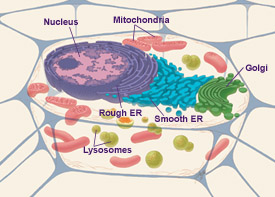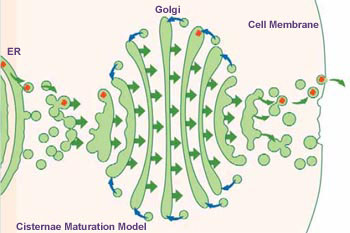Chapter 1
An Owner's Guide to the Cell
By Alisa Zapp Machalek
Welcome! I hope the transformation wasn't too alarming. You have shrunk down to about 3 millionths of your normal size. You are now about 0.5 micrometers tall (a micrometer is 1/1000 of a millimeter). But don't worry, you'll return to your normal size before you finish this chapter.
At this scale, a medium-sized human cell looks as long, high, and wide as a football field. But from where we are, you can't see nearly that far. Clogging your view is a rich stew of molecules, fibers, and various cell structures called organelles. Like the internal organs in your body, organelles in the cell each have a unique biological role to play.
Now that your eyes have adjusted to the darkness, let's explore, first-hand and up close, the amazing world inside a cell.
Nucleus: The Cell's Brain
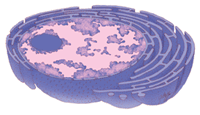
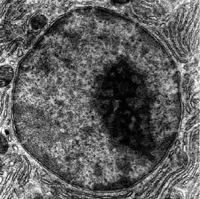
Look down. Notice the slight curve? You're standing on a somewhat spherical structure about 50 feet in diameter. It's the nucleus—basically the cell's brain.
The nucleus is the most prominent organelle and can occupy up to 10 percent of the space inside a cell. It contains the equivalent of the cell's gray matter—its genetic material, or DNA. In the form of genes, each with a host of helper molecules, DNA determines the cell's identity, masterminds its activities, and is the official cookbook for the body's proteins.
Go ahead—jump. It's a bit springy, isn't it? That's because the nucleus is surrounded by two pliable membranes, together known as the nuclear envelope. Normally, the nuclear envelope is pockmarked with octagonal pits about an inch across (at this scale) and hemmed in by raised sides. These nuclear pores allow chemical messages to exit and enter the nucleus. But we've cleared the nuclear pores off this area of the nucleus so you don't sprain an ankle on one.
If you exclude the nucleus, the rest of the cell's innards are known as the cytoplasm.
| Eukaryotic Cells | Prokaryotic Cells |
|---|---|
| The cells of “complex” organisms, including all plants and animals | “Simple” organisms, including bacteria and blue-green algae |
| Contain a nucleus and many other organelles, each surrounded by a membrane (the nucleus and mitochondrion have two membranes) | Lack a nucleus and other membrane-encased organelles |
| Can specialize for certain functions, such as absorbing nutrients from food or transmitting nerve impulses; groups cells can form large, multicellular organs and organisms | Usually exist as single, virtually identical cells |
| Most animal cells are 10–30 micrometers across, and most plant cells are 10–100 micrometers across | Most are 1–10 micrometers across |
Virtually all forms of life fall into one of two categories: eukaryotes or prokaryotes.
Cell Membrane: Specialist in Containing and Communicating
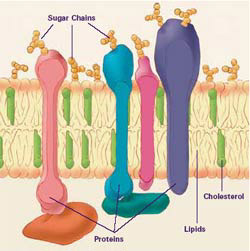
Click for larger image
You may not remember it, but you crossed a membrane to get in here. Every cell is contained within a membrane punctuated with special gates, channels, and pumps. These gadgets let in—or force out—selected molecules. Their purpose is to carefully protect the cell's internal environment, a thick brew (called the cytosol) of salts, nutrients, and proteins that accounts for about 50 percent of the cell's volume (organelles make up the rest).
The cell's outer membrane is made up of a mix of proteins and lipids (fats). Lipids give membranes their flexibility. Proteins transmit chemical messages into the cell, and they also monitor and maintain the cell's chemical climate. On the outside of cell membranes, attached to some of the proteins and lipids, are chains of sugar molecules that help each cell type do its job. If you tried to bounce on the cell's outer surface as you did on the nuclear membrane, all these sugar molecules and protruding proteins would make it rather tricky (and sticky).
Endoplasmic Reticulum: Protein Clothier and Lipid Factory
If you peer over the side of the nucleus, you'll notice groups of enormous, interconnected sacs snuggling close by. Each sac is only a few inches across but can extend to lengths of 100 feet or more. This network of sacs, the endoplasmic reticulum (ER), often makes up more than 10 percent of a cell's total volume.
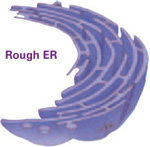
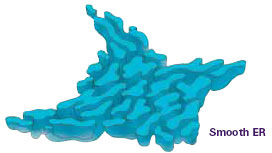
Take a closer look, and you'll see that the sacs are covered with bumps about 2 inches wide. Those bumps, called ribosomes, are sophisticated molecular machines made up of more than 70 proteins and 4 strands of RNA, a chemical relative of DNA. Ribosomes have a critical job: assembling all the cell's proteins. Without ribosomes, life as we know it would cease to exist.
To make a protein, ribosomes weld together chemical building blocks one by one. As naked, infant protein chains begin to curl out of ribosomes, they thread directly into the ER. There, hard-working enzymes clothe them with specialized strands of sugars.
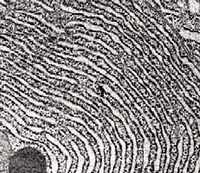
SUSUMU ITO
Now, climb off the nucleus and out onto the ER. As you venture farther from the nucleus, you'll notice the ribosomes start to thin out. Be careful! Those ribosomes serve as nice hand- and footholds now. But as they become scarce or disappear, you could slide into the smooth ER, unable to climb out.
In addition to having few or no ribosomes, the smooth ER has a different shape and function than the ribosome-studded rough ER. A labyrinth of branched tubules, the smooth ER specializes in synthesizing lipids and also contains enzymes that break down harmful substances. Most cell types have very little smooth ER, but some cells—like those in the liver, which are responsible for neutralizing toxins—contain lots of it.
Next, look out into the cytosol. Do you see some free-floating ribosomes? The proteins made on those ribosomes stay in the cytosol. In contrast, proteins made on the rough ER's ribosomes end up in other organelles or are sent out of the cell to function elsewhere in the body. A few examples of proteins that leave the cell (called secreted proteins) are antibodies, insulin, digestive enzymes, and many hormones.
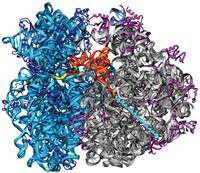
IMAGE COURTESY OF HARRY NOLLER
All cellular organisms, including bacteria, have ribosomes. And all ribosomes are composed of proteins and ribosomal RNA. But the precise shapes of these biological machines differ in several very specific ways between humans and bacteria. That's a good thing for researchers trying to develop bacteria-killing medicines called antibiotics because it means that scientists may be able to devise therapies that knock out bacterial ribosomes (and the bacteria along with them) without affecting the human hosts.
Several antibiotic medicines currently on the market work by inhibiting the ribosomes of bacteria that cause infections. Because many microorganisms have developed resistance to these medicines, we urgently need new antibiotics to replace those that are no longer effective in fighting disease.
Using sophisticated imaging techniques like X-ray crystallography, researchers have snapped molecular pictures of antibiotics in the act of grabbing onto a bacterial ribosome. Studying these three-dimensional images in detail gives scientists new ideas about how to custom design molecules that grip bacterial ribosomes even more strongly. Such molecules may lead to the development of new and more effective antibiotic drugs. —Alison Davis
Golgi: Finishing, Packaging, and Mailing Centers
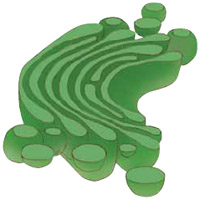
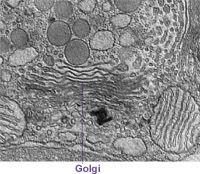
Now, let's slog through the cytosol a bit. Notice that stack of a half dozen flattened balloons, each a few inches across and about 2 feet long? That's the Golgi complex, also called the Golgi apparatus or, simply, the Golgi. Like an upscale gift shop that monograms, wraps, and mails its merchandise, the Golgi receives newly made proteins and lipids from the ER, puts the finishing touches on them, addresses them, and sends them to their final destinations. One of the places these molecules can end up is in lysosomes.
Lysosomes: Recycling Centers and Garbage Trucks
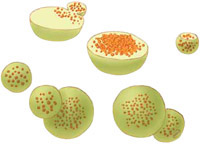
See that bubble about 10 feet across? That's a lysosome. Let's go—I think you'll like this. Perhaps even more than other organelles, lysosomes can vary widely in size—from 5 inches to 30 feet across.
Go ahead, put your ear next to it. Hear the sizzling and gurgling? That's the sound of powerful enzymes and acids chewing to bits anything that ends up inside.
But materials aren't just melted into oblivion in the lysosome. Instead, they are precisely chipped into their component parts, almost all of which the cell recycles as nutrients or building blocks. Lysosomes also act as cellular garbage trucks, hauling away unusable waste and dumping it outside the cell. From there, the body has various ways of getting rid of it.
Mitochondria: Cellular Power Plants
Blink. Breathe. Wiggle your toes. These subtle movements—as well as the many chemical reactions that take place inside organelles—require vast amounts of cellular energy. The main energy source in your body is a small molecule called ATP, for adenosine triphosphate.
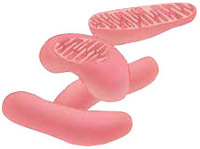
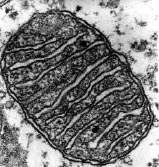
D.S. FRIEND, BRIGHAM AND WOMEN'S HOSPITAL
ATP is made in organelles called mitochondria. Let's see if we can find some. They look like blimps about as long as pickup trucks but somewhat narrower. Oh, a few of them are over there. As we get nearer, you may hear a low whirring or humming sound, similar to that made by a power station. It's no coincidence. Just as power plants convert energy from fossil fuels or hydroelectric dams into electricity, mitochondria convert energy from your food into ATP.
Like all other organelles, mitochondria are encased in an outer membrane. But they also have an inner membrane. Remarkably, this inner membrane is four or five times larger than the outer membrane. So, to fit inside the organelle, it doubles over in many places, extending long, fingerlike folds into the center of the organelle. These folds serve an important function: They dramatically increase the surface area available to the cell machinery that makes ATP. In other words, they vastly increase the ATP-production capacity of mitochondria.
The mazelike space inside mitochondria is filled with a strong brew of hundreds of enzymes, DNA (mitochondria are the only organelles to have their own genetic material), special mitochondrial ribosomes, and other molecules necessary to turn on mitochondrial genes.
| ACTUAL SIZE (AVERAGE) | PERCEIVED SIZE WHEN MAGNIFIED 3 MILLION TIMES | |
|---|---|---|
| Cell diameter | 30 micrometers* | 300 feet |
| Nucleus diameter | 5 micrometers | 50 feet |
| Mitochondrion length | Typically 1–2 micrometers, but can be up to 7 micrometers long | 18 feet |
| Lysosome diameter | 50–3,000 nanometers* | 5 inches to 30 feet |
| Ribosome diameter | 20–30 nanometers | 2–3 inches |
| Microtubule width | 25 nanometers | 3 inches |
| Intermediate filament width | 10 nanometers | 1.2 inches |
| Actin filament width | 5–9 nanometers | 0.5–1 inch |
*A micrometer is one millionth (10-6) of a meter. A nanometer is one billionth (10-9) of a meter.
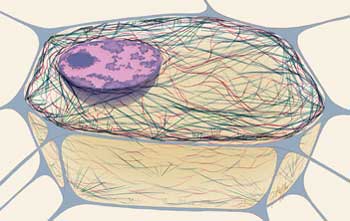
Cytoskeleton: The Cell’s Skeleton...and More
Now, about all those pipes, ropes, and rods you've been bumping into. Together, they are called the cytoskeleton—the cell's skeleton. Like the bony skeletons that give us stability, the cytoskeleton gives our cells shape, strength, and the ability to move, but it does much more than that.
Think about your own cells for a moment. Right now, some of your cells are splitting in half, moving, or changing shape. If you are a man, your sperm use long tails called flagella to swim. If you are a woman, hairlike fibers called cilia sweep newly released eggs from your ovaries into your uterus. And all that is thanks to the cytoskeleton.
As you can see, the cytoskeleton is incredibly versatile. It is made up of three types of fibers that constantly shrink and grow to meet the needs of the cell: microtubules, intermediate filaments, and actin filaments. Each type of fiber looks, feels, and functions differently.
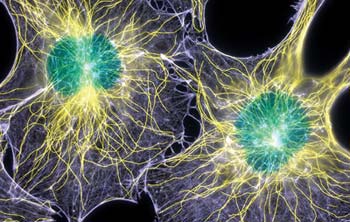
TORSTEN WITTMANN
The 3-inch-wide flexible pipes you just banged your head on are called microtubules. Made of the strong protein tubulin, microtubules are the heavy lifters of the cytoskeleton. They do the tough physical labor of separating duplicate chromosomes when cells copy themselves and serve as sturdy railway tracks on which countless molecules and materials shuttle to and fro. They also hold the ER and Golgi neatly in stacks and form the main component of flagella and cilia.
Grab one of those inch-thick ropes. Yeah, you can swing on it—it won't snap. These strands, called intermediate filaments, are unusual because they vary greatly according to their location and function in the body. For example, some intermediate filaments form tough coverings, such as in nails, hair, and the outer layer of skin (not to mention animal claws and scales). Others are found in nerve cells, muscle cells, the heart, and internal organs. In each of these tissues, the filaments are made of different proteins. So if doctors analyze intermediate filaments in tumors, they can determine the origin of—and possible treatments for—some kinds of cancer.
See that bundle of long rods near the edge of the cell? You can touch it, but don't try to bend the rods. They shatter easily. These rods, slightly thinner than intermediate filaments, are actin filaments. They are made up of two chains of the protein actin twisted together. Although actin filaments are the most brittle of the cytoskeletal fibers, they are also the most versatile in terms of the shapes they can take. They can gather together into bundles, weblike networks, or even three-dimensional gels. They shorten or lengthen to allow cells to move and change shape. Together with a protein partner called myosin, actin filaments make possible the muscle contractions necessary for everything from your action on a sports field to the automatic beating of your heart.
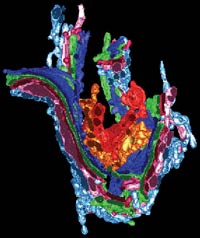
Scientists use a variety of techniques to study organelles like the endoplasmic reticulum and Golgi, gaining ever more detailed understanding of these minute but very complicated structures. For example, Kathryn Howell of the University of Colorado School of Medicine in Denver uses a specialized high-voltage electron microscope, rapid freezing methods, and a computer modeling program to obtain a vivid three-dimensional view of the Golgi and the pathways that proteins use to exit it.
Howell begins by quick-freezing living cells, embedding them in plastic, and slicing the plastic-coated sample into thin sections. As she tilts the microscope stage, she can capture many images of the same region of the sample. A computer assembles these images to form a three-dimensional view, called a tomogram, of the Golgi and other organelles. Based on the tomogram, Howell's research team can produce a movie of a virtual journey through the cell. You can see one such movie at http://publications.nigms.nih.gov/insidethecell/extras.
Howell's research shows that there are several pathways for proteins and other molecules to exit the Golgi. The findings are revealing, as earlier studies using different methods had suggested that there was only one road out of this organelle. No doubt new chapters to this story will be written as biologists and computer scientists create even more sophisticated tools for imaging cells. —A.D.
The Tour Ends Here
You've seen quite a bit of the cell in a short time. However, this tour covered only the highlights; there are many other fascinating processes that occur within cells. Every day, cell biologists learn more, but much remains unexplained.
You will now regain your normal size. There should be no lasting side effects of the miniaturization, except, I hope, a slight tingling sensation caused by new knowledge and a growing excitement about what scientists know—and still don't know—about cells.
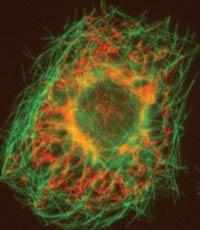
MICHAEL YAFFE
Scientists such as Michael P. Yaffe of the University of California, San Diego, study what mitochondria look like and how they change throughout a cell's life. To approach this research problem, Yaffe uses simple organisms—such as yeast or fruit fly cells—which, like your own cells, have membranes, a nucleus, and other organelles. This similarity makes these organisms important models for understanding human biology.
Yaffe's work helped change the textbook depiction of mitochondria as kidney bean-shaped organelles. Using advanced microscopy, Yaffe and others have unveiled many different shapes for mitochondria, ranging from the classic beans to long snakes and weblike structures, all of which are thought to change on a constant basis. Researchers are discovering that the different mitochondrial shapes accompany changes in cellular needs, such as when growing cells mature into specific types or when a cell responds to disease.
Many scientists believe that mitochondria—which divide on their own, have their own genome and protein-making machinery, and resemble prokaryotes in many ways—are descendents of oxygen-loving microorganisms that were taken in by primitive cells. This historical event set the stage for advanced life forms like plants and animals. —A.D.
Cool Tools for Studying Cells
Cell biologists would love to do what you just did—shrink down and actually see, touch, and hear the inner workings of cells. Because that's impossible, they've developed an ever-growing collection of approaches to study cellular innards from the outside. Among them are biochemistry, physical analysis, microscopy, computer analysis, and molecular genetics. Using these techniques, researchers can exhaustively inventory the individual molecular bits and pieces that make up cells, eavesdrop on cellular communication, and spy on cells as they adapt to changing environments. Together, the approaches provide vivid details about how cells work together in the body's organs and tissues. We'll start by discussing the traditional tools of the trade—microscopes—then touch on the new frontiers of quantum dots and computational biology.
Light Microscopes: The First Windows Into Cells

IMAGE COURTESY OF THE NATIONAL MUSEUM OF HEALTH AND MEDICINE, ARMED FORCES INSTITUTE OF PATHOLOGY, WASHINGTON, DC
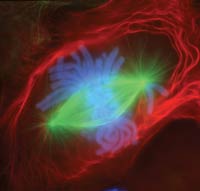
CONLY RIEDER
Scientists first saw cells by using traditional light microscopes. In fact, it was Robert Hooke (1635–1703), looking through a microscope at a thin slice of cork, who coined the word "cell." He chose the word to describe the boxlike holes in the plant cells because they reminded him of the cells of a monastery.
Scientists gradually got better at grinding glass into lenses and at whipping up chemicals to selectively stain cellular parts so they could see them better. By the late 1800s, biologists already had identified some of the largest organelles (the nucleus, mitochondria, and Golgi).
Researchers using high-tech light microscopes and glowing molecular labels can now watch biological processes in real time. The scientists start by chemically attaching a fluorescent dye or protein to a molecule that interests them. The colored glow then allows the scientists to locate the molecules in living cells and to track processes—such as cell movement, division, or infection—that involve the molecules.
Fluorescent labels come in many colors, including brilliant red, magenta, yellow, green, and blue. By using a collection of them at the same time, researchers can label multiple structures inside a cell and can track several processes at once. The technicolor result provides great insight into living cells—and is stunning cellular art.
Electron Microscopes: The Most Powerful of All
In the 1930s, scientists developed a new type of microscope, an electron microscope that allowed them to see beyond what some ever dreamed possible. The revolutionary concept behind the machine grew out of physicists' insights into the nature of electrons.
As its name implies, the electron microscope depends not on light, but on electrons. The microscopes accelerate electrons in a vacuum, shoot them out of an electron gun, and focus them with doughnut-shaped magnets. As the electrons bombard the sample, they are absorbed or scattered by different cell parts, forming an image on a detection plate.
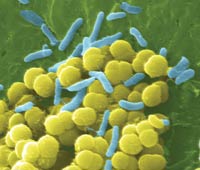
TINA CARVALHO
Although electron microscopes enable scientists to see things hundreds of times smaller than anything visible through light microscopes, they have a serious drawback: They can't be used to study living cells. Biological tissues don't survive the technique's harsh chemicals, deadly vacuum, and powerful blast of electrons.
Electron microscopes come in two main flavors: transmission and scanning. Some transmission electron microscopes can magnify objects up to 1 million times, enabling scientists to see viruses and even some large molecules. To obtain this level of detail, however, the samples usually must be sliced so thin that they yield only flat, two-dimensional images. Photos from transmission electron microscopes are typically viewed in black and white.
Scanning electron microscopes cannot magnify samples as powerfully as transmission scopes, but they allow scientists to study the often intricate surface features of larger samples. This provides a window to see up close the three-dimensional terrain of intact cells, material surfaces, microscopic organisms, and insects. Scientists sometimes use computer drawing programs to highlight parts of these images with color.
Studying Single Molecules: Connecting the Quantum Dots
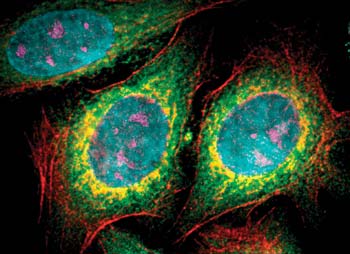
QUANTUM DOT CORP., HAYWARD, CA
Whether they use microscopes, genetic methods, or any other technique to observe specific molecules, scientists typically flag every molecule of a certain type, then study these molecules as a group. It's rather like trying to understand a profession—say, teaching, architecture, or medicine—by tagging and observing all the workers in that profession simultaneously. Although these global approaches have taught us a lot, many scientists long to examine individual molecules in real time—the equivalent of following individual teachers as they go about their daily routines.
Now, new techniques are beginning to allow scientists to do just that. One technology, called quantum dots, uses microscopic semiconductor crystals to label specific proteins and genes. The crystals, each far less than a millionth of an inch in diameter, radiate brilliant colors when exposed to ultraviolet light. Dots of slightly different sizes glow in different fluorescent colors—larger dots shine red, while smaller dots shine blue, with a rainbow of colors in between. Researchers can create up to 40,000 different labels by mixing quantum dots of different colors and intensities as an artist would mix paint. In addition to coming in a vast array of colors, the dots also are brighter and more versatile than more traditional fluorescent dyes: They can be used to visualize individual molecules or, like the older labeling techniques, to visualize every molecule of a given type.
Quantum dots promise to advance not only cell biology but also a host of other areas. Someday, the technology may allow doctors to rapidly analyze thousands of genes and proteins from cancer patients and tailor treatments to each person's molecular profile. These bright dots also could help improve the speed, accuracy, and affordability of diagnostic tests for everything from HIV infection to allergies. And, when hitched to medicines, quantum dots might deliver a specific dose of a drug directly to a certain type of cell.
Computers Clarify Complexity
Say you're hungry and stranded in a blizzard: If you eat before you seek shelter, you might freeze to death, but if you don't eat first, you might not have the strength to get yourself out of the storm. That's analogous to the decisions cells have to make every day to survive.
For years, scientists have examined cell behaviors—like the response to cold or hunger—one at a time. And even that they did bit by bit, laboriously hammering out the specific roles of certain molecules. This approach made it difficult or impossible to study the relative contributions of—and the interplay between—genes that share responsibility for cell behaviors, such as the 100 or so genes involved in the control of blood pressure.
Now, computers are allowing scientists to examine many factors involved in cellular behaviors and decisions all at the same time. The field of computational biology blossomed with the advent of high-end computers. For example, sequencing the 3.2 billion base pairs of the human genome, which was completed in 2003, depended on computers advanced enough to tackle the challenge. Now, state-of-the-art equipment and a wealth of biological data from genome projects and other technologies are opening up many new research opportunities in computer analysis and modeling. So, much as microscopes and biochemical techniques revolutionized cell biology centuries ago, computers promise to advance the field just as dramatically in this new century.
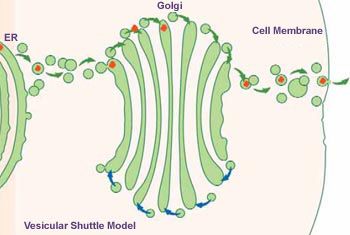
Click to view the Vehicular Shuttle Model animation
One great thing about science is that you're allowed to argue about your work.
To gain new information, scientists ask a lot of questions. Often, the answers spur more questions. The never-ending circle not only feeds curiosity; it also can lead to important and sometimes unexpected breakthroughs. Sometimes, scientists studying the same topic but using different experimental approaches come up with different conclusions.
Take the Golgi, for example. Think it's noncontroversial? The details of how this organelle forms inside your cells have kept two camps of researchers in a lively battle.
On one side of the debate is Graham Warren of Yale University School of Medicine in New Haven, Connecticut, who argues that the Golgi is an architectural structure that cannot be made from scratch. He believes that newly made proteins are packaged in the rough ER and are sent for further processing to a pre-existing structure (the Golgi) that is made up of different compartments. This is called the vesicular shuttle model.
On the other side is Jennifer Lippincott-Schwartz of the National Institute of Child Health and Human Development (part of the National Institutes of Health) in Bethesda, Maryland. She says that the Golgi makes itself from scratch. According to her theory, packages of processing enzymes and newly made proteins that originate in the ER fuse together to form the Golgi. As the proteins are processed and mature, they create the next Golgi compartment. This is called the cisternae maturation model. You can see animations of the two different models at http://publications.nigms.nih.gov/insidethecell/extras/.
Intriguing new data suggest that perhaps neither model is completely correct. This will likely lead to yet another model. You may not see what all the fuss is about, but the differing Golgi theories say very different things about how cells function. Understanding basic cellular processes, such as how the Golgi works, ultimately can have a profound impact on the development of methods to diagnose, treat, and prevent diseases that involve those processes.
What are cells, and why is it important to study them?
List five different organelles and describe what they do.
Name three techniques that scientists use to study cells.
What are the differences between prokaryotic and eukaryotic cells?


